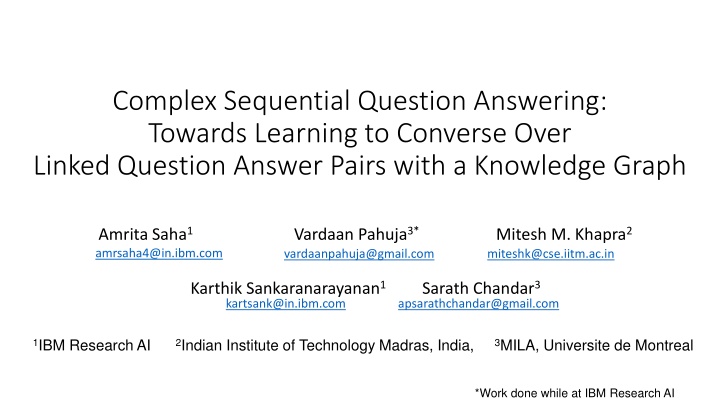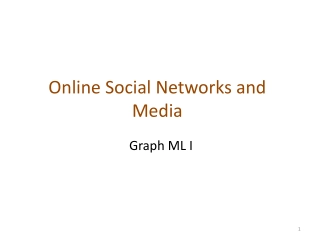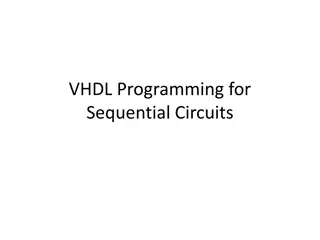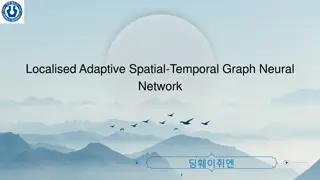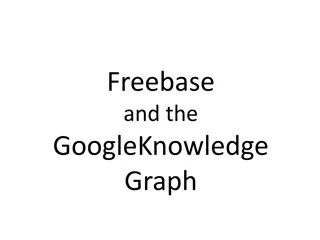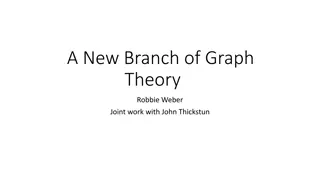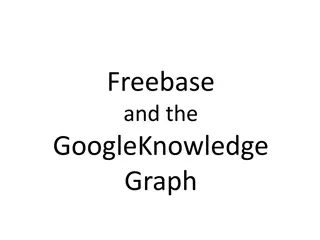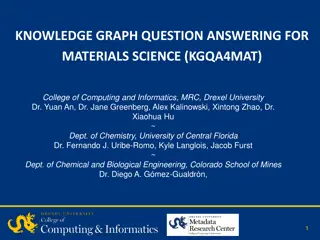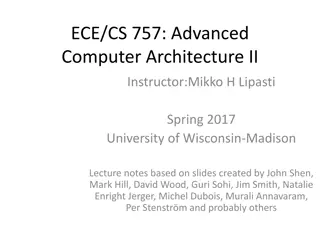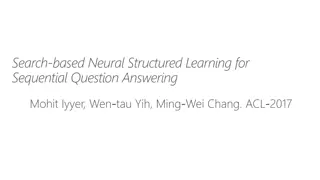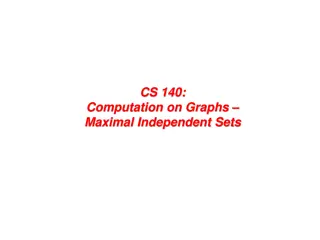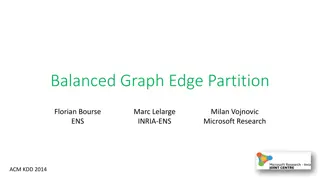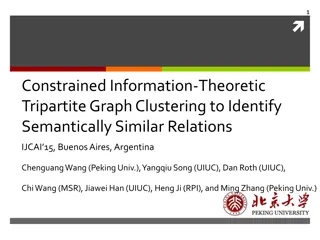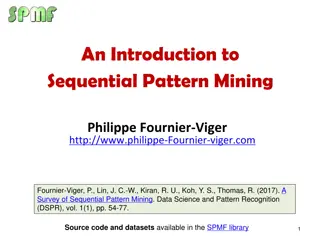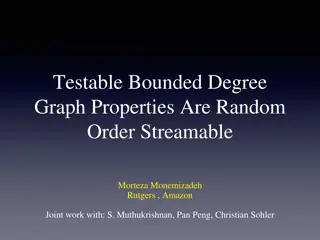Complex Sequential QA with Knowledge Graph
Introducing a new dataset for Complex Sequential Question Answering over a large-scale Knowledge Base, highlighting the need and encouraging the research community to develop models for complex QA tasks.
Download Presentation

Please find below an Image/Link to download the presentation.
The content on the website is provided AS IS for your information and personal use only. It may not be sold, licensed, or shared on other websites without obtaining consent from the author.If you encounter any issues during the download, it is possible that the publisher has removed the file from their server.
You are allowed to download the files provided on this website for personal or commercial use, subject to the condition that they are used lawfully. All files are the property of their respective owners.
The content on the website is provided AS IS for your information and personal use only. It may not be sold, licensed, or shared on other websites without obtaining consent from the author.
E N D
Presentation Transcript
Complex Sequential Question Answering: Towards Learning to Converse Over Linked Question Answer Pairs with a Knowledge Graph Amrita Saha1 amrsaha4@in.ibm.com Vardaan Pahuja3* vardaanpahuja@gmail.com Mitesh M. Khapra2 miteshk@cse.iitm.ac.in Karthik Sankaranarayanan1 kartsank@in.ibm.com Sarath Chandar3 apsarathchandar@gmail.com 1IBM Research AI 2Indian Institute of Technology Madras, India, 3MILA, Universite de Montreal *Work done while at IBM Research AI
Outline Introduce a new dataset for Complex Sequential QA over a large- scale Knowledge Base Motivate the need for such a dataset Highlight the poor performance of the state-of-the-art models on this new dataset Encourage the research community to develop models for such complex QA tasks
Existing KB based QA/Conversation Datasets Restaurant reservation ( Bordes and Weston 2016) Size of KB (Knowledge Base) is toyish (< 10 cuisines, locations, ambience, etc.) Very few states in dialog SimpleQuestions Dataset (Bordes 2015) Q/A over a Large KB of millions of entities Consisting of only simple questions requiring single tuple lookup in the KB Not in a dialog setting Sequential Question Answering (SQA, 2016) Complex QA pairs are linked as in a dialog Q/A over small tables and not a KB Only 17 K questions and a few other datasets
Wishlist for a new KB based Sequential QA Dataset KB based Challenges Need for a realistic scale Knowledge Base (of atleast few millions of entities) Go beyond simple questions, which are answerable from a single KB tuple, to more complex questions Need for sequences of different inferencing (logical/comparative/quantitative) over larger subgraphs of the KB Conversational Challenges Use conversation context to resolve co-references and ellipsis in utterances Ask for clarifications for ambiguous queries
Wishlist for a new KB based Sequential QA Dataset KB based Challenges Need for a realistic scale Knowledge Base (of atleast few millions of entities) Go beyond simple questions, which are answerable from a single KB tuple, to more complex questions Need for sequences of different inferencing (logical/comparative/quantitative) over larger subgraphs of the KB . In our new dataset on Complex Sequential Question Answering over KB (CSQA) Conversational Challenges Use conversation context to resolve co-references and ellipsis in utterances Ask for clarifications for ambiguous queries
Highlights of the CSQA Dataset Question Answering is done over WikiData, an open-domain KB, having 13 Million entities and 21 Million facts With the help of domain experts, we designed 19 dialog states each comprising of simple or complex types of questions answerable from subgraphs of the KB Further designed an automata over the dialog states to create non goal- oriented dialogs Instantiated the automata to create 200K such dialogs with a total of 1.6 M QA turns.
Link to Download Dataset Dataset is available at https://amritasaha1812.github.io/CSQA/ Updated version of the paper and results are in https://arxiv.org/abs/1801.10314
Challenges in Complex Sequential QA over KB
User: Can you tell me which cities border Verderio Inferiore? System: Cornate d Adda, Bernareggio, Robbiate User: And which cities flank that one ? System: Did you mean Robbiate ? User: No, I meant Cornate d Adda System: Bottanuco, Busnago, Trezzo sull Adda User: Which ones share border with Robbiate and are not part of Azerbaijan ? System: Trezzo sull Adda, Busnago, Bottanuco User: Which city is the capital of minimum number of french administrative divisions ? System: Riga User: How many political territories have strategic relation with around 22 other countries ? System: 11 User: Which countries have lesser number of political relations with others than Australia ? System: Denmark, Canada, Grenada
User: Can you tell me which cities border Verderio Inferiore? Simple Question System: Cornate d Adda, Bernareggio, Robbiate User: And which cities flank that one ? System: Did you mean Robbiate ? User: No, I meant Cornate d Adda System: Bottanuco, Busnago, Trezzo sull Adda User: Which ones share border with Robbiate and are not part of Azerbaijan ? System: User: Trezzo sull Adda, Busnago, Bottanuco Which city is the capital of minimum number of french administrative divisions ? System: Riga User: How many political territories have strategic relation with around 22 other countries ? System: 11 User: Which countries have lesser number of political relations with others than Australia ? System: Denmark, Canada, Grenada
User: Can you tell me which cities border Verderio Inferiore? System: Cornate d Adda, Bernareggio, Robbiate Ellipses and coreference resolution required User: And which cities flank that one ? System: Did you mean Robbiate ? Clarification required for ambiguous question User: No, I meant Cornate d Adda System: Bottanuco, Busnago, Trezzo sull Adda User: Which ones share border with Robbiate and are not part of Azerbaijan ? System: User: Trezzo sull Adda, Busnago, Bottanuco Which city is the capital of minimum number of french administrative divisions ? System: Riga User: How many political territories have strategic relation with around 22 other countries ? System: 11 User: Which countries have lesser number of political relations with others than Australia ? System: Denmark, Canada, Grenada
User: Can you tell me which cities border Verderio Inferiore? System: Cornate d Adda, Bernareggio, Robbiate User: And which cities flank that one ? Requires Logical inferencing e.g. set difference operation over two subgraphs of the KB System: Did you mean Robbiate ? User: No, I meant Cornate d Adda System: Bottanuco, Busnago, Trezzo sull Adda User: Which ones share border with Robbiate and are not part of Azerbaijan ? System: User: Trezzo sull Adda, Busnago, Bottanuco Which city is the capital of minimum number of french administrative divisions ? System: Riga User: How many political territories have strategic relation with around 22 other countries ? System: 11 User: Which countries have lesser number of political relations with others than Australia ? System: Denmark, Canada, Grenada
User: Can you tell me which cities border Verderio Inferiore? System: Cornate d Adda, Bernareggio, Robbiate User: And which cities flank that one ? Quantitative Reasoning (e.g. minimum) over a collection of subgraphs of the KB System: Did you mean Robbiate ? User: No, I meant Cornate d Adda System: Bottanuco, Busnago, Trezzo sull Adda User: Which ones share border with Robbiate and are not part of Azerbaijan ? System: Trezzo sull Adda, Busnago, Bottanuco User: Which city is the capital of minimum number of french administrative divisions ? System: Riga User: How many political territories have strategic relation with around 22 other countries ? System: 11 User: Which countries have lesser number of political relations with others than Australia ? System: Denmark, Canada, Grenada
User: Can you tell me which cities border Verderio Inferiore? System: Cornate d Adda, Bernareggio, Robbiate User: And which cities flank that one ? System: Did you mean Robbiate ? User: No, I meant Cornate d Adda System: Bottanuco, Busnago, Trezzo sull Adda User: Which ones share border with Robbiate and are not part of Azerbaijan ? System: Trezzo sull Adda, Busnago, Bottanuco User: Which city is the capital of minimum number of french administrative divisions ? Quantitative reasoning over multiple subgraph of the KB System: Riga User: How many political territories have strategic relation with around 22 other countries ? System: 11 User: Which countries have lesser number of political relations with others than Australia ? System: Denmark, Canada, Grenada
User: Can you tell me which cities border Verderio Inferiore? System: Cornate d Adda, Bernareggio, Robbiate User: And which cities flank that one ? System: Did you mean Robbiate ? User: No, I meant Cornate d Adda System: Bottanuco, Busnago, Trezzo sull Adda User: Which ones share border with Robbiate and are not part of Azerbaijan ? System: Trezzo sull Adda, Busnago, Bottanuco User: Which city is the capital of minimum number of french administrative divisions ? System: Riga User: How many political territories have strategic relation with around 22 other countries ? Comparative Reasoning between multiple subgraphs of the KB System: 11 User: Which countries have lesser number of political relations with others than Australia ? System: Denmark, Canada, Grenada
State-of-the-art models for KB based QA
State-of-the-art* performance on CSQA Question Type Overall Simple Question (Direct) Simple Question (Co-referenced) Simple Question (Ellipsis) Logical Reasoning (All) Quantitative Reasoning (All) Comparative Reasoning (All) Clarification Question Type Verification (Boolean) (All) Quantitative Reasoning (Count) (All) Comparing Reasoning (Count) (All) Recall (%) 18.4 33.3 12.67 17.3 15.11 0.913 Precision (%) 6.3 8.58 5.09 6.98 4.75 1.01 2.11 4.97 25.09 12.13 Accuracy (%) *System used here is a state-of-the-art Neural model based on Key Value Memory Network [Miller et al. 2016] with a hierarchical encoder for encoding a dialog context 21.04 12.13 8.67
State-of-the-art* performance on CSQA Question Type Overall Simple Question (Direct) Simple Question (Co-referenced) Simple Question (Ellipsis) Logical Reasoning (All) Quantitative Reasoning (All) Comparative Reasoning (All) Clarification Question Type Verification (Boolean) (All) Quantitative Reasoning (Count) (All) Comparing Reasoning (Count) (All) Recall (%) 18.4 33.3 12.67 17.3 15.11 0.913 Precision (%) 6.3 8.58 5.09 Answer is a set of KB entities 6.98 4.75 1.01 2.11 4.97 25.09 12.13 Accuracy (%) 21.04 Answer is a set of booleans or integers 12.13 8.67
State-of-the-art* performance on CSQA Question Type Overall Simple Question (Direct) Simple Question (Co-referenced) Simple Question (Ellipsis) Logical Reasoning (All) Quantitative Reasoning (All) Comparative Reasoning (All) Clarification Question Type Verification (Boolean) (All) Quantitative Reasoning (Count) (All) Comparing Reasoning (Count) (All) Recall (%) 18.4 33.3 12.67 17.3 15.11 0.913 Precision (%) 6.3 8.58 5.09 Questions with co-reference and ellipsis is significantly harder to answer than direct questions 6.98 4.75 1.01 2.11 4.97 25.09 12.13 Accuracy (%) 21.04 12.13 8.67
State-of-the-art performance on CSQA Question Type Overall Simple Question (Direct) Simple Question (Co-referenced) Simple Question (Ellipsis) Logical Reasoning (All) Quantitative Reasoning (All) Comparative Reasoning (All) Clarification Question Type Verification (Boolean) (All) Quantitative Reasoning (Count) (All) Comparing Reasoning (Count) (All) Recall (%) 18.4 33.3 12.67 17.3 15.11 0.913 Precision (%) 6.3 8.58 5.09 6.98 4.75 1.01 State-of-the-art models are not appropriate for modeling complex question answering 2.11 4.97 25.09 12.13 Accuracy (%) 21.04 12.13 8.67
State-of-the-art performance on CSQA Question Type Overall Simple Question (Direct) Simple Question (Co-referenced) Simple Question (Ellipsis) Logical Reasoning (All) Quantitative Reasoning (All) Comparative Reasoning (All) Clarification Question Type Verification (Boolean) (All) Quantitative Reasoning (Count) (All) Comparing Reasoning (Count) (All) Recall (%) 18.4 33.3 12.67 17.3 15.11 0.913 Precision (%) 6.3 8.58 5.09 6.98 4.75 1.01 2.11 4.97 25.09 12.13 These models cannot perform quantitative reasoning, they treat integers also as vocabulary words Accuracy (%) 21.04 12.13 8.67
State-of-the-art performance on CSQA Question Type Overall Simple Question (Direct) Simple Question (Co-referenced) Simple Question (Ellipsis) Logical Reasoning (All) Quantitative Reasoning (All) Comparative Reasoning (All) Clarification Question Type Verification (Boolean) (All) Quantitative Reasoning (Count) (All) Comparing Reasoning (Count) (All) Recall (%) 18.4 33.3 12.67 17.3 15.11 0.913 Precision (%) 6.3 8.58 5.09 6.98 4.75 1.01 If memory based models are used, complex question answering would require large memory (>100K tuples) 2.11 4.97 25.09 12.13 Accuracy (%) 21.04 12.13 8.67
Conclusion Introduced a dataset of 200K dialogs of over 1.6M Question-Answer pairs covering 19 different simple and complex Question Types Showed how each of the complex questions need sequences of logical, quantitative and comparative reasoning over subgraphs of the million-sized open-domain KB Wikidata Highlighted the limitations of current neural models in handling complex QA over such large scale KBs With this, we encourage research into learning to converse over complex KB based question-answering
Question Types Reasoning Type Containing Example Union/ Intersection/ Difference Single Relation Which rivers flow through India and/or/but not China? Logical Which river flows through India but does not originate in Himalayas? Any of above Multiple Relations Boolean Single/Multiple Entities Does Ganga flow through India ? Verification Single/Multiple Entity Type How many rivers (and lakes) flow through India ? Count Logical Operators How many rivers flow through India and/or/but not China? Min/Max Single/Multiple Entity Type Which country has maximum number of rivers (and lakes)? Quantitative Atleast/ Atmost/ Approx/ Equal Single/Multiple Entity Type Which country has at least N rivers (and lakes) ? Count over Single/Multiple Entity Type How many countries have at least N rivers (and lakes)? Atleast /Atmost /Approx /Equal More/Less Single/Multiple Entity Type Which countries have more rivers (and lakes) than India ? Comparative How many countries have more number of rivers (and lakes) than India ? Count over More/Less Single/Multiple Entity Type
Key-Value Memory Network Hierarchical Encoder Decoder Decoding Boolean/ Numerical Responses/ <KG> placeholders Hops j = 1, , H Value Key embedding k(khj) embedding v(vhj) </s> <KG-entity> </e> Dialog context representation Context hidden state Memory q1 qH+1 Rj Encoder hidden state Inner Product o B BTqH+1 v(vi) softmax Where does he live? Narendra Modi Who s the PM of India Softmax score over memory entries Memory User s Utterance 1 System s Utterance 1 User s Utterance 2 <New Delhi> Response KG entities
Key-Value Memory Network Hierarchical Encoder Decoder Decoding Boolean/ Numerical Responses/ <KG> placeholders Hops j = 1, , H Value Key embedding k(khj) embedding v(vhj) </s> <KG-entity> </e> Dialog context representation Context hidden state Memory Pre-trained TransE embeddings active for the KG entity q1 qH+1 Rj Encoder hidden state o Inner Product B BTqH+1 v(vi) softmax Glove embeddings active for non KG word Memory Softmax score over memory entries Where does he live? <Narendra Modi> Who s the PM of <India> Embedding(KG entity) = Concat( TransE Embedding(KG Entity), Zero Embedding ) Embedding(non-KG word) = Concat (Zero Embedding, Glove Embedding (non-KG word)) Where does he live? Narendra Modi Who s the PM of India <New Delhi> Response KG entities Tokenization into query words (e.g. Who, the, live) and KG entities (e.g. India, Narendra Modi) User s Utterance 1 System s Utterance 1 User s Utterance 2
Dataset statistics Dataset Statistics Train Valid Test 200,000 dialogs 3.2 million utterances (1.6 M turns) Wikidata as KG 12.8 M entities 330 unique relations 21.2 M tuples 642 entity types Total No. of Dialogs(chat sessions) 152391 16413 27797 Avg. No. of Utterances per dialog 15.9 15.65 19.44 Total No. of Utterances having Question/Answer 1.2M .13M .27M Length of user s question (in words) 9.7 9.68 10.28 Length of system s response (in words) 4.74 4.67 4.37 Avg. No. of Dialog states per dialog 3.89 3.84 4.53 Vocab size (freq>=10) - - 0.1M
Example dialog (see more in git repo) USER: Which people were casted in The 36th Chamber of Shaolin ? SPEAKER: Gordon Liu, Lo Lieh USER: Which works of art stars Gordon Liu and Lo Lieh as actor ? SPEAKER: Kill Bill Volume 1, Flying Swords of Dragon Gate, The Man with the Iron Fists USER: Which language was used originally for the creation of that work of art ? SPEAKER: Did you mean Kill Bill Volume 1 ? USER: No, I meant The Man with the Iron Fists. Could you tell me the answer for that? SPEAKER: English USER: How many notations are used as the scripts for approximately the same number of languages as Coptic alphabet ? SPEAKER: 4 USER: And what about Bamum script? SPEAKER: 4 USER: Which languages are English or Latin script the writing system of ? SPEAKER: The answer count is 33. Do you want to see all possibilities? USER: No, show only a few of them SPEAKER: Norn, Wailaki language, Slavoserbian, Polabian, Sierra Puebla Nahuatl, Basque, Gaulish, Central Nahuatl, Pangasinan language, Nynorsk USER: Which languages have writing system as English and Latin script ? SPEAKER: Pangasinan language, Wailaki language, Gaulish, Norn, Central Nahuatl, Slavoserbian, Basque, Sierra Puebla Nahuatl, Polabian, Nynorsk USER: How many notations are the writing systems used for approximately 1 language ? SPEAKER: 4 USER: How many classification schemes are English a component of ? SPEAKER: 2 USER: And also tell me about German submarine U-42? SPEAKER: 1
